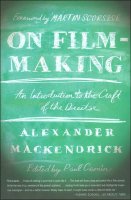Book Review: Alexander Mackendrick, On Film-Making: An Introduction to the Craft of the Director
reviewed by dan heaton

Director Alexander Mackendrick is not a household name to many cinema lovers, including this reviewer, but he helmed a string of impressive films during the '50s and '60s. His most recognizable works include the original version of The Ladykillers with Alec Guiness and the classic Sweet Smell of Success with Tony Curtis and Burt Lancaster. In 1969, Mackendrick accepted the position as Dean of the Film and Video School at the California Institute of Arts and moved into the academic setting. On Film-Making provides a collection of his noteworthy essays concerning the directing process that should be compelling for students of the craft.
Martin Scorsese's forward gives a quick overview of Mackendrick and touts the benefits of this compilation. Editor Paul Cronin's much lengthier introduction is a bit text-heavy, but it does provide readers with detailed personal recollections and quotes from the man himself. The book is separated into two primary sections, Dramatic Construction and Film Grammar. The first portion includes 17 informative descriptions about the basic elements of script creation and focuses on the pratfalls that can doom a good idea. The highlight is "Once Upon a Time..," an exploration of the truly concise nature of storytelling through a comparison of three highly disparate works. Beginning with the title phrase and following the path of a typical children's tale, Mackendrick compares the directions of Cinderella, The Bicycle Thief, and Hamlet and shows how they simply offer variations on a basic structure. Another worthy essay is "Density and Subplot in Sweet Smell of Success," which explores this story's text in extreme detail. This section could be overwhelming to readers unfamiliar with the film, but it does provide for an intriguing model.
Depending on your interest in film directing, On Film-Making could be equally compelling or maddening. Readers looking for a more straightforward explanation about the craft should probably look elsewhere. The Film Grammar section involves numerous drawings that did not really draw my interest, but those same sections could inspire serious film students. The high level of detail is impressive, regardless of this particular reviewer's interest in each chapter. The final chapter covers Citizen Kane and actually looks at a scene that was not in the film in an attempt to explore the editing process. This essay was not as interesting as I expected, but my mental exhaustion by this point could have played a role. This essay offers another example of my overall impression of this book, which succeeds as a film-school textbook but is not the best choice for the everyday movie lover.
Copyright (c) 2005 erasing clouds |
|